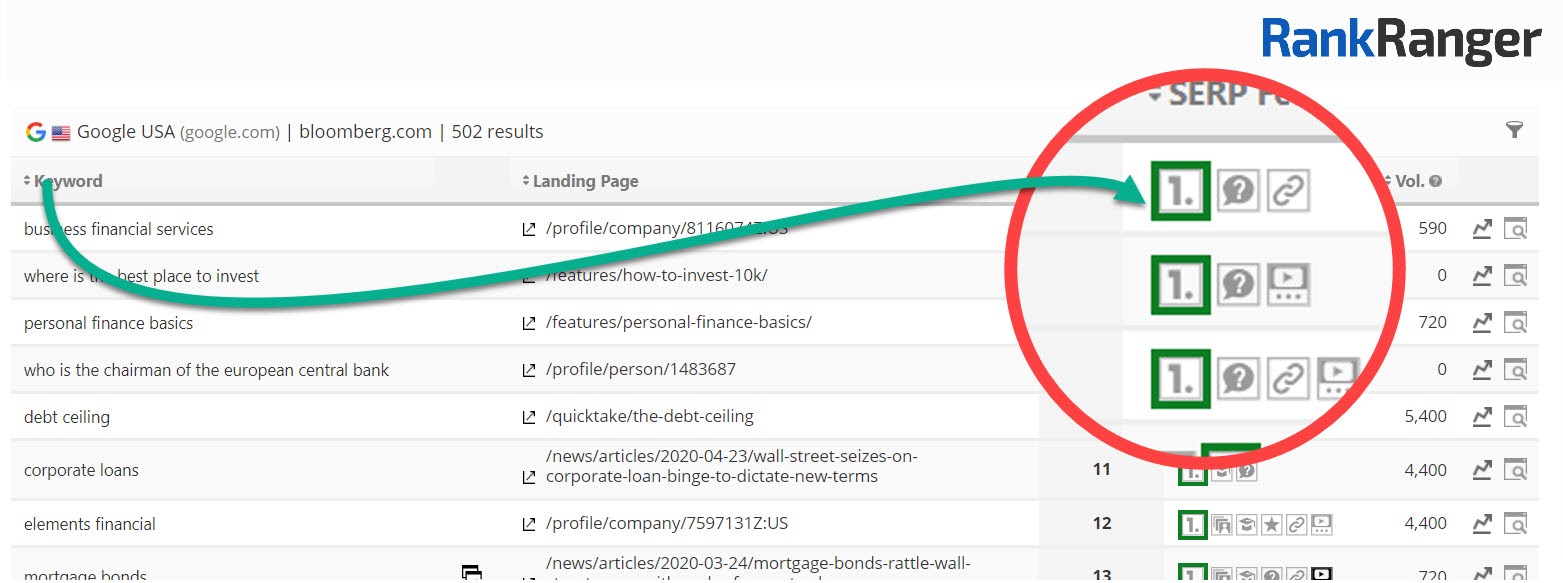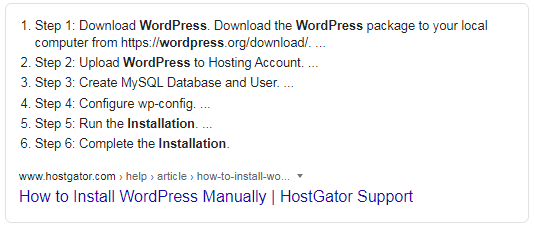Posted by
Darrell Mordecai
SEO is a long term game. No question about that. Although there generally are no shortcuts, Google has given us a unique opportunity.
Featured Snippets.
Not a magic bullet, Featured Snippets tend to attract more attention than regular organic rankings. This means they have potentially higher click through rates than even the top-ranking URLs.

I wrote this two-part guide to be a thorough how-to manual to winning Featured Snippets. Although it is written in a step-by-step format so that a beginner can follow it, I have included some advanced strategies for those of you already experienced in the art of SEO.
Before we dive in, it’s important to point out that there is no definitive guide to winning Featured Snippets. Everything I am sharing here is based on experience or research.
In part one of this guide we will be covering:
- Why Google creates Featured Snippets in the first place
- How to find Featured Snippet opportunities
Let’s jump in…
Why Does Google Produce Featured Snippets in the First Place?
The first step to winning Featured Snippets is to understand Google’s ‘why’. This is important so that you can align your content with Google’s goals. When you do that, you’ll be able to partner up with Google in creating quality content for the end-user. Aligning your goals with Google is likely to result in a big win for your site (all things being equal).
Google is Helping the User
Picture this…
You have a big Zoom meeting coming up. You’ve never used Zoom before and being like me, you leave finding how it works to the last possible minute.
The meeting is happening in three minutes and forty-six seconds. You need to figure this out now. Okay, time to turn to Google.
But wait.
You can’t possibly wade through a 2000-word article now. After typing how to use zoom into Google you see this:
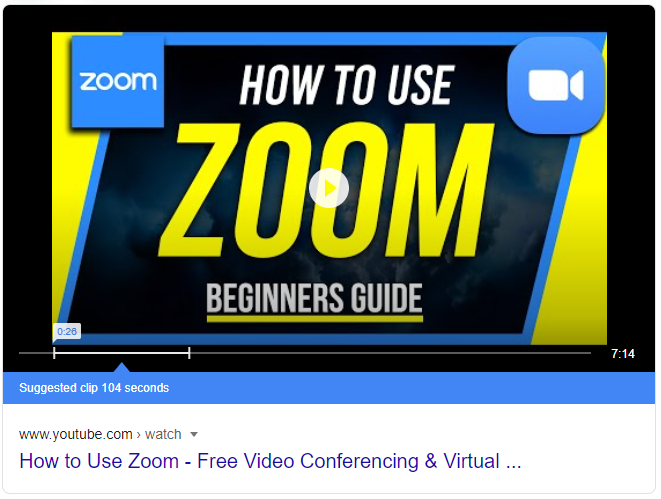
Google has just presented a YouTube video that you’re able to watch right there in the SERP. Not only that but if you click the video, Google even sends you to the actual clip that will answer your question, saving you precious time. No need to watch the introduction.
The takeaway is Google is serving the user by supplying a short answer to the search query in the SERP.
In fact, Google is not only seeking to provide the user with short snippets of content but, at times, to completely satisfy the user so that no further exploration is needed. We saw evidence of this when we ran a study on Featured Snippet length in 2019.
When we compared Featured Snippets that appeared on the SERP between 2017 and 2018 with the Featured Snippets from 2019, we noticed that list snippets had become longer and paragraph snippets had become shorter.
When trying to understand the reason for this trend, one thing became obvious. When list posts are longer, they are more complete. This means the user gets a more complete answer to their burning question right there in the SERP.
When we looked at why paragraph snippets are shorter, we noticed that the paragraphs are becoming simpler and clearer. Google is getting better at cutting out unnecessary words and details. The net result? Featured Snippets have become much better at answering the searcher’s query.
Now, you might be wondering, if Featured Snippets are complete answers, why would a user want to click through to your site? True, not every Featured Snippet will get you clicks to the extent you might think, however, many will. (I’ll cover which Featured Snippets to go after and which to avoid later in the post.)
Now that you understand the motivation behind Featured Snippets you should understand the mindset behind optimizing your pages. When the user types something into Google, they are in essence asking a question. Can this question be answered with a short summary? Will a short paragraph, bulleted list, or video quickly answer the user’s question? The more simple and accurate the answer, the better the Featured Snippet will be.
What Does Google Get out of Featured Snippets?
Now, you might be thinking, what does Google get out of creating all these short summaries for the user? This is a well-debated topic in the SEO community. What’s our take?
Positioning.
It’s in Google’s best interest to position the search engine as an authority. When a searcher types a question into Google, if the query is answered by SERP features, Google becomes the authority, not the site from where the results came from. For instance, if you type ‘who is Clint Eastwood’ into Google you might see this:
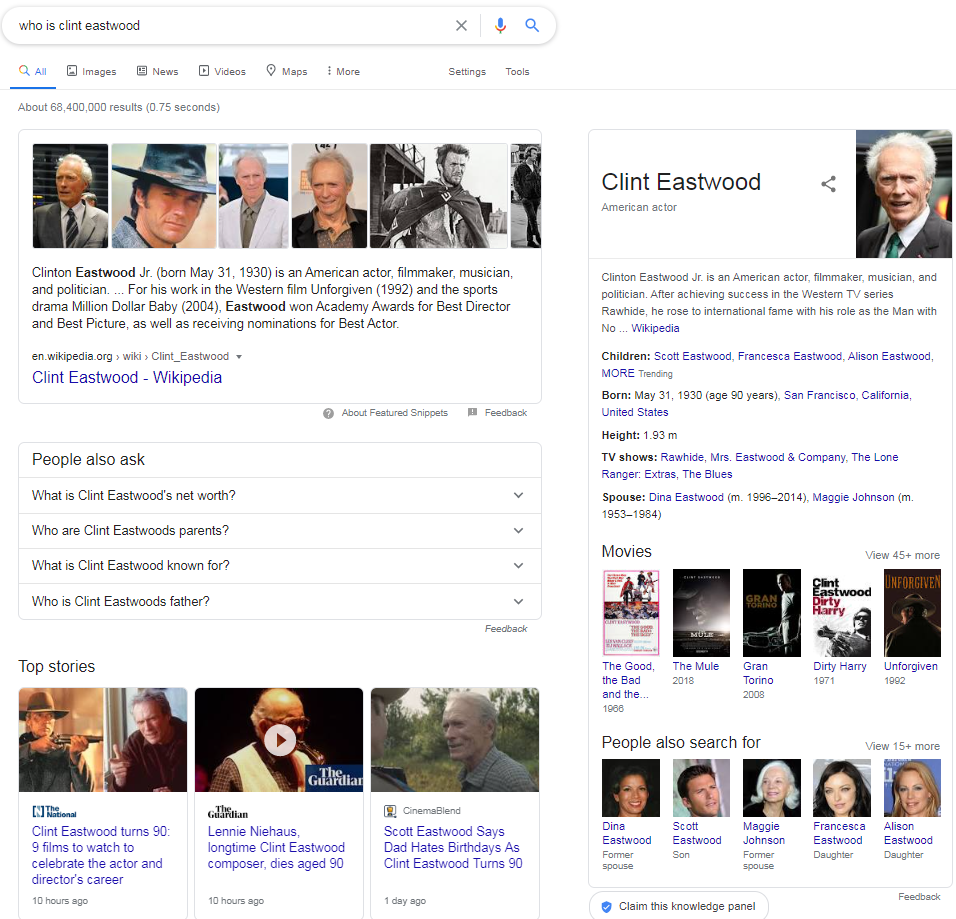
Even though Google didn’t actually create this information, Google curated it. The user, however, doesn’t think about that. To the user, the information came directly from Google. What this means to you is you should be creating highly authoritative content, because Google will be using it to boost its own authority.
You should now have a pretty good understanding as to why Google creates these SERP features. With this mindset, you are all set to find Featured Snippet opportunities.
In the next section, we’ll be going through exactly how you find pages that are likely to have Featured Snippet wins. Not only that, but we will also learn how to qualify which Featured Snippets to go after, and which ones you shouldn’t touch with a ten-foot barge pole.
Let’s jump right in.
Research: How to Find Featured Snippet Opportunities
If you are creating a new piece of content, or you have already existing content, you should be researching how your content can stand out to Google and answer the user’s questions. In order to do effective research, you have to know what you’re looking for. Here is my process.
In this section, I won’t be showing you how to optimize your content, just how to find opportunities. I’ll be covering how to optimize your content in part two of this guide.
How to Find Pages Likely to Win Featured Snippets
Although it was not true in the past, Google now relates to Featured Snippets as organic results. Long gone are the days when a Featured Snippet was considered position zero. Google now relates to them as position one.
This creates a slight difficulty for us. Previously, Google would present the same URL both in the Featured Snippet and as an organic result. Having a corresponding organic result meant we could see where the Featured Snippet was coming from. In those days research showed that Google would draw the Featured Snippet primarily from results in positions six and above.
This meant that the content with the best chance of winning a Featured Snippet came from URLs that ranked at position six or above.
Now that Google relates to Featured Snippets as position one, and there is no corresponding organic result, there is no way to know if Google favors any rank positions when creating Featured Snippets. With some optimization, are you more likely to win a Featured Snippet if your URL is in position two as opposed to position ten? No one knows as that entire construct doesn’t exist anymore.
So where do we start then? My suggestion? Try to work with content that’s ranking as high on page one in Google as possible. All things being equal, the higher the rank the more relevant the result is. So in all likelihood the higher the rank, the better chance that the URL is “Featured Snippet worthy.” Of course, there may not be much of a difference in a URL that ranks #3 vs. #4 for a given query. Which is why I recommend you focus on URLs that rank towards the top of the SERP, and not on any specific position.
In starting with pages that already rank well, you’re taking the most efficient step you can towards winning a Featured Snippet. (Of course, this page will need to be improved upon, but that’s for later. Right now we’re just finding the most advantageous pages on your site for Featured Snippet wins.)
Finding top-ranking pages is easy to do. Just open up your favorite rank tracking tool. For this post, I’ll show you how you can find pages that are ready to win Featured Snippets by using Rank Ranger. I’ll also share some strategies that don’t need a rank tracker at all.
First, open up the Featured Snippet Report in the Rank Insights Report. This will show you a list of your keywords, starting from your top-ranking ones and working its way down. The report also shows you which URLs are ranking for those keywords.
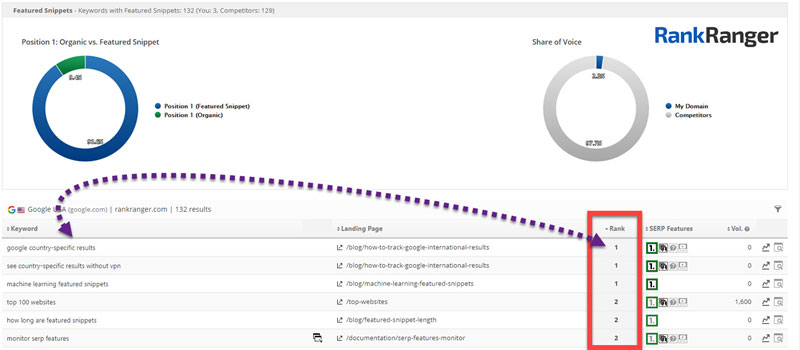
As I mentioned above, all things being equal, your pages with the best chance of winning Featured Snippets are the ones ranking highly on the search engine results pages (SERPs). However, having URLs that are ranking highly in Google is not enough. We need to qualify this further. You’re looking for pages that are ranking near the top, on SERPs that are already showing Featured Snippets. (There’s no point in going after a Featured Snippet when none exist.)
Now, you could go to the SERPs and take a look, but when working at scale, a tool like the Featured Snippet report will tell you which keywords produce a Featured Snippet. If you look to the right of the Rank column, you’ll see the SERP features column. This column will tell you if there are any Featured Snippets showing up for your keyword.
As you will see in the image below, the icons with the green frames are Featured Snippets ranking on those SERPs. You’ll notice that the icons are light grey. This means the Featured Snippet spots are currently occupied by your competition.
These are all good candidates for Featured Snippets.
But don’t start optimizing your pages just yet, we still need to qualify whether your site has any chance of winning these top spots. Don’t worry, I’ll cover that later in the post. But, before we get there, you might have a burning question.
What if you don’t have any page one rankings yet?
If you don’t have any pages on page one of Google, but you are actively creating content, you really should consider researching Featured Snippet opportunities.
What do I mean?
Although you shouldn’t be creating content just to win Featured Snippets, I assume you’re creating content that is designed to make it to the top of Google. I also assume in the planning stage you know which keywords you want those pages to rank for.
To find Featured Snippet opportunities, make sure you’re tracking those keywords. You can then use the Featured Snippet Report to see any keywords that have Featured Snippet opportunities, even if your site is not ranking for those keywords. See the screenshot below:

The Featured Snippet Report showing Featured Snippet opportunities where none of the tracked domain’s pages are ranking on page one
How to Qualify Your Chances of Actually Winning a Featured Snippet
Whether you’re creating new content or trying to get your page one rankings to the top, you must know if the Featured Snippet you’ve set your sights on is worth pursuing. Some will not bring you much traffic, others might be too difficult to win, others might only show a Featured Snippet for your keyword for a limited time.
Assess your Chances of Winning
Interesting fact. There are Featured Snippets that Google considers to be extremely authoritative answers. Once Google decides this, the URL will show in the Featured Snippet fairly consistently, day after day. In a study on Featured Snippets we did found that Google only “toys” with using two URLs for a Featured Snippet over a 30-day period. Of those two URLs, one of them claims the Featured Snippet 75% of the time on average.
So how do you know if there’s a chance of not only being shown inside a Featured Snippet but having your URL appear within it more than a fraction of the time?
To assess this, you can use the SERP Features Monitor in Rank Ranger. For instance, if we look at the term ‘residential home security systems’ you’ll see a completely authoritative Featured Snippet.

SERP Features monitor showing Google featuring a single URL inside a Featured Snippet over a 30 day period
In the screenshot above, there is an unbroken blue line right at the top of the graph. This tells you the Featured Snippet showed up on the SERP every day for 30 days straight.
The verdict? Don’t even bother with this one. There’s no room for your content. (We’re not saying it’s impossible to claim a Featured Snippet like this, but this may not be the best place to focus when you have other opportunities.)
Instead, you should be looking for a SERP where Google is constantly testing different Featured Snippets. When this happens, Google is most likely not happy with what’s currently ranking and is looking for something better. As you can see in the screenshot below, over a period of 30 days, Google tested four different URLs. None of which lasted more than seven consecutive days. Here is a great opportunity for you to create something that Google is happy with.
In the above scenario, the Featured Snippet is open for the taking. But as I mentioned above, you’re very likely to find instances where one URL is utilized in the Featured snippet the vast majority of the time and another URL around 25% of the time.
In other words, Google often picks a dominant Featured Snippet URL that shows up the majority of the time and chooses a challenger Featured Snippet that shows up around 25% of the time. The challenger is seen as less relevant in Google’s eyes. What’s interesting is, that even if Google introduces a third URL, the dominant URL will keep its market share.
As you can see in the screenshot below, for the search term ‘what does situational awareness mean’ the SERP Features Monitor shows rcog.org in the dominant Featured Snippet URL, as it shows up in a Featured Snippet about 83.33% of the time (over a 30-day period), while wikipedia.org only shows up 16.67% of the time.
This means even if you win a Featured Snippet, your page might only be considered a challenger URL. The takeaway here is, if you can’t find any pages where you can get a dominant URL position, your second best option is to be a challenger URL.
You’ll still get the benefits of having your URL inside a Featured Snippet, but you might not get as much traffic as you’d hope for. Also, with time Google might promote your content to being the dominant URL.
How to Get Featured Snippet Wins When Your Search Terms Are Too Competitive
If you’ve tried to win a Featured Snippet, and no matter how hard you try, you just can’t chisel your way in, perhaps the SERP is too competitive. If this happens, don’t give in, there are two ways you can win a Featured Snippet for this page.
Option One:
Since your page is already ranking on page one of Google for a topic, it’s highly likely you’ll be able to also rank your page for a subtopic around your main page topic if you aren’t already. Your goal here is to have your page rank on a different SERP that is less competitive, without losing your current ranking.
What do I mean?
Imagine your page is ranking for the term ‘best way to drink beer’. Consider this your main topic. If you’ve tried and simply can’t get a Featured Snippet win on this page, you can try to add sub-topic information to your page.
A simple way to find a viable sub-topic is to take a look at the current ranking Featured Snippet.

Look at the example above. Read through the bullet points one through four. The fourth bullet talks about the best temperature to drink beer. Perhaps this will make a good sub-topic within your article. If your sub-topic section is thorough enough, there is a good chance your article could appear on a SERP for that sub-topic without too much work.
In order to research this, you’ll have to formulate a question around drinking beer and temperature. Try to imagine what someone would type into Google if they wanted to know what temperature to drink beer at (or do a bit of keyword research).
For instance, you can try:
- Best temperature to drink beer at
- What temperature should I drink beer at
- Should beer be drunk at room temperature
- When drinking beer, what temperature should it be at
Once you have some ideas, take a look at the Featured Snippet Report to see if there is a Featured Snippet opportunity for any of those terms. If there are, you can use the SERP Features Monitor to measure how competitive they are (as mentioned above). Once you have some terms with Featured Snippet opportunities, check if any of those keywords have enough search volume that will justify spending the time to win a Featured Snippet. If one of them does, you’ve found a winner.
Once you’ve found a sub-topical keyword to focus on, it pays to visit the SERP to get a handle on what Google is currently showing with the Featured Snippet. This will help you to understand how to optimize your page to trigger a Featured Snippet for the sub-topical keyword you chose to focus on (more on this in part 2 of this guide).
If you don’t have a rank tracker that tells you Featured Snippet volatility, you’ll have to do some SERP analysis. To do this, type your potential search terms into Google.
For our example, I’ve typed ‘should beer be drunk at room temperature’, and this is what I found:
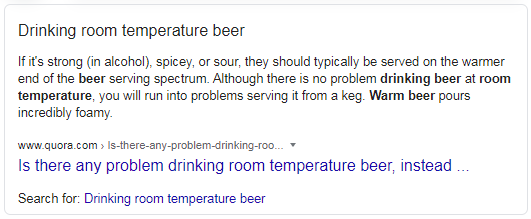
Here, to assess your chances of winning this Featured Snippet, you’ll have to use visual clues. Is the text awkward? Does it answer the searcher’s question in a satisfying way? If not, you have a good shot at winning the Featured Snippet. There is more to it than this, and I’ll cover it in more detail part two of this guide.
Option two:
Another way you can do this is to look for a long-tail keyword that your content is already ranking on page one for. You can easily find this in your favorite rank tracking tool. However, if you’re not tracking any long-tail keywords, you can use Google Search Console.
To do that, log into Search Console and click on the Pages report. Scroll through to find the page you are working with. Click on the page’s URL and you’ll see data for that page. Next, click on the queries report.
Make sure the Average Position checkbox is clicked. You’ll now see a list of keywords your URL is ranking for. Look for a keyword that has an Average Position of ten or less.
Being on position ten or less means your page is likely to be on page one of Google. This is a rough estimate that needs to be qualified (as Search Console’s rank data can be less than reliable at times). To qualify it, make sure the page is also getting a decent amount of impressions, and hopefully some clicks. As you can see in the screenshot below, ‘situational awareness exercises’, ‘situational exercises’ and ‘situational awareness practical exercises’ are all good options. They’re above position 10, are getting impressions and some clicks.
Since Search Console is known to be somewhat inaccurate, you can qualify it further by typing the keyword into Google and looking to see if your URL is there. You should preferably do this in an incognito browser window. While you’re on the SERP, you should look to see if there are any Featured Snippets that you want to win.
The advantage of using this method is you don’t have to first rank on page one, as you can choose a query that your content already ranks for on page one. However, the downside to using a long-tail keyword, is they generally get lower search volume, so you should only try to win Featured Snippets on SERPs with enough search volume.
Assess the Featured Snippet Clickability
Okay, you’ve found some great Featured Snippet opportunities. But wait. Don’t optimize anything yet. Some Featured Snippets are complete answers in and of themselves. This means the searcher will get exactly what they were looking for right there in the SERP. When this happens, your piece of content is likely to get way less traffic than what you’d hope for.
A great example of this is the Featured Snippet for the term ‘how old is earth’.
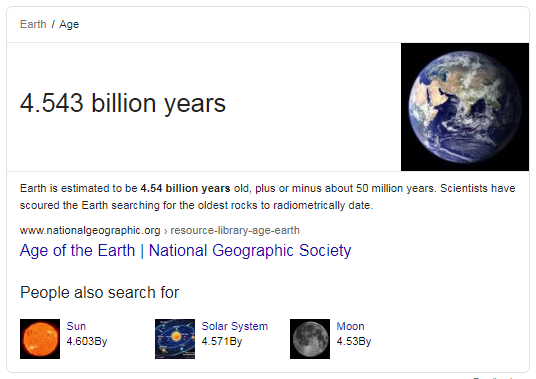
In this case, if by seeing the Featured Snippet, the searcher’s question is answered, they’re less likely to click through to the article. I’m not saying there will be no clicks to the content, but having a Featured Snippet that provides a complete and simple answer to a question is likely to give the user less reason to click through to the content.
However, even if you don’t get as much traffic as you’d like, having your content at the top of Google is still great for branding.
But if traffic is your main goal, you should avoid Featured Snippets with complete answers. To identify them, type the search term you are thinking about targeting into Google and look at the current Featured Snippet. Since there are no tools that measure this to my knowledge, you’ll have to use your common sense. Ask yourself, if you were searching for this term, would this Featured Snippet satisfy you?
On the other hand, if you want traffic to your site, what type of Featured Snippets should you be looking for?
Featured Snippets that get the most clicks are ones that offer incomplete information (and that deal with more complex topics). For instance, if you type ‘how to install WordPress’ into Google, you’ll see the this Featured Snippet:
As you can see the information doesn’t answer the searcher’s query. Each item is truncated leaving incomplete sentences. The only way for the searcher to get a satisfactory answer is to click through to the article.
Qualify SERP Consistency Across Device
At this stage, you should have some Featured Snippets that your pages have a good chance of appearing in. You should also be able to qualify which ones will bring you the most traffic. There is one last thing to consider during the research stage…
Some Featured Snippets will not appear across desktop and mobile consistently. In fact, we researched this and found that on average, a SERP will not show a Featured Snippet with the same URL on both devices around 30% of the time.
In cases like these, you might be losing out on traffic potential. For instance, if your traffic is primarily coming from mobile and the Featured Snippet is not always shown on mobile, you are likely to get substantially less targeted traffic. However, the flip side of this is if it’s showing on both devices, you’ll get more bang for your buck. This should be considered when targeting a Featured Snippet.
For instance, in the screenshot below, you’ll see a Featured Snippet report for the term ‘how to cut butternut squash’ on desktop. Here,over a 30 day period, the SERP showed a Featured Snippet day after day for all 30 days. The URL allrecipes.com showed up in the Featured Snippet for 27 out of the 30 days.
For the same query on mobile you’ll see something completely different. Here, the SERP shows a Featured Snippet for the same URLs. However, neither URL appeared in a Featured Snippet for more than three days in a row. What’s more, for the vast majority of the month, no Featured Snippet appeared at all.
The takeaway here is, for this term, winning a Featured Snippet is likely to give you more desktop traffic than mobile traffic.
We’re Not Finished Yet

Okay, you now understand the mindset behind winning Featured Snippets. You also understand how to find Featured Snippet opportunities and more importantly how to qualify them.
In the next post, I’ll be covering how you can take what you’ve learned in this post, and start to optimize your content to actually win Featured Snippets. What I’ll be sharing in the next post will build off this one, so make sure to review what I’ve covered here.

